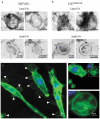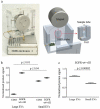Large and small extracellular vesicles released by glioma cells in vitro and in vivo
- PMID: 31839905
- PMCID: PMC6896449
- DOI: 10.1080/20013078.2019.1689784
Large and small extracellular vesicles released by glioma cells in vitro and in vivo
Abstract
Tumour cells release diverse populations of extracellular vesicles (EVs) ranging in size, molecular cargo, and function. We sought to characterize mRNA and protein content of EV subpopulations released by human glioblastoma (GBM) cells expressing a mutant form of epidermal growth factor receptor (U87EGFRvIII) in vitro and in vivo with respect to size, morphology and the presence of tumour cargo. The two EV subpopulations purified from GBM U87EGFRvIII cancer cells, non-cancer human umbilical vein endothelial cells (HUVEC; control) and serum of U87EGFRvIII glioma-bearing mice using differential centrifugation (EVs that sediment at 10,000 × g or 100,000 × g are termed large EVs and small EVs, respectively) were characterized using transmission electron microscopy (TEM), confocal microscopy, nanoparticle tracking analysis (NTA), flow cytometry, immunofluorescence (IF), quantitative-polymerase chain reaction (qPCR), droplet digital polymerase chain reaction (ddPCR) and micro-nuclear magnetic resonance (μNMR). We report that both U87EGFRvIII and HUVEC release a similar number of small EVs, but U87EGFRvIII glioma cells alone release a higher number of large EVs compared to non-cancer HUVEC. The EGFRvIII mRNA from the two EV subpopulations from U87EGFRvIII glioma cells was comparable, while the EGFR protein (wild type + vIII) levels are significantly higher in large EVs. Similarly, EGFRvIII mRNA in large and small EVs isolated from the serum of U87EGFRvIII glioma-bearing mice is comparable, while the EGFR protein (wild type + vIII) levels are significantly higher in large EVs. Here we report for the first time a direct comparison of large and small EVs released by glioma U87EGFRvIII cells and from serum of U87EGFRvIII glioma-bearing mice. Both large and small EVs contain tumour-specific EGFRvIII mRNA and proteins and combining these platforms may be beneficial in detecting rare mutant events in circulating biofluids.
Keywords: Extracellular vesicles; biomarkers; glioma; large extracellular vesicles; small extracellular vesicles.
© 2019 The Author(s). Published by Informa UK Limited, trading as Taylor & Francis Group on behalf of The International Society for Extracellular Vesicles.
Figures




References
-
- Wang J, Bettegowda C.. Applications of DNA-based liquid biopsy for central nervous system neoplasms. J Mol Diagn. 2017;19:24–10. - PubMed
Grants and funding
LinkOut - more resources
Full Text Sources
Other Literature Sources
Research Materials
Miscellaneous

